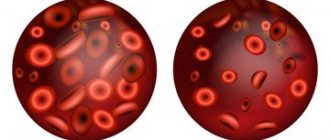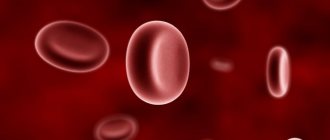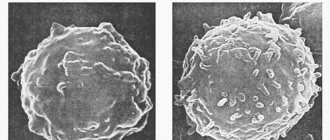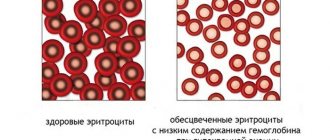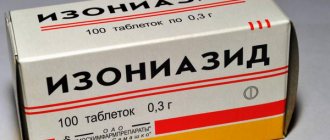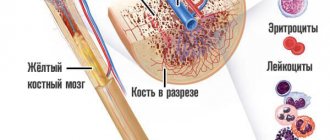Violations of the basic functions of hematopoiesis occur in the practice of hematologists in a variety of forms and types. In most cases, these are quite dangerous disorders that, without treatment, lead to serious complications. Although in a situation where the body is able to compensate for the disorder, the patient does not even suspect the presence of any problem.
Poikilocytosis is a disorder of the normal synthesis of red blood cells by the body: formed cells become abnormal, taking on a strange, atypical shape.
They usually have the structure of a regular sphere. In the case of the development of a pathological process, we are talking about pear-shaped, sickle-shaped, ruptured fragmentary forms (schizocytes) and other options. It is clear that such abnormal cells completely or partially lose their own functions.
Symptoms appear when the damage is sufficiently severe or when the disorder turns into decompensation, when the patient’s body is not able to independently correct the deviation.
Treatment is required in all cases, since without therapy it is impossible to talk about the prospects for recovery. Gradually the condition will worsen.
What is poikilocytosis and how is it treated?
But sometimes laboratory tests reveal a pathology in which red blood cells change: instead of being round, they take on the shape of an oval, sickle, ellipse or pear. This transformation is called poikilocytosis. We will look in detail at the types, causes of the anomaly, diagnostic, therapeutic and preventive measures, and features of the manifestation of the disease in children of any age in the article.
Diagnostics
Only a hematologist can diagnose “poikilocytosis in a blood test.” This specialist can determine the underlying etiological factor that caused the development of red blood cell abnormalities. The main diagnostic procedure is a general clinical blood test.
It is impossible to accurately identify the main provoking source based on just one analysis; an integrated approach is required. Diagnostics will include a wide range of laboratory and instrumental examinations.
First of all, it is necessary to carry out the following actions:
- study of medical history;
- familiarization with family history;
- collection and analysis of life history;
- assessment of the condition of the skin, visible mucous membranes, hair and nail plates;
- measurement of heart rate, blood tone and temperature;
- detailed survey - to compile a complete symptomatic picture.
Additional laboratory tests are represented by the following tests:
- blood chemistry;
- hormonal and immunological tests;
- liver and PCR tests;
- bacterial blood culture.
Instrumental procedures include:
- EFGDS;
- ultrasonography of the liver and kidneys;
- radiography of the abdominal organs;
- CT and MRI of internal organs.
What is poikilocytosis
Poikilocytosis (anisopoikilocytosis) is an abnormal or pathological phenomenon in which erythrocyte cells are modified in metric characteristics (shape, size) and poorly transport oxygen from the lungs to the tissues and back, as a result of which the body’s performance is impaired. Often the pathology indicates signs of the initial stage of anemia - anisocytosis.
Some red blood cells - echinocytes and stomatocytes - can often be restored, but the remaining pathological forms - acanthocytes, drepanocytes, codocytes, dacryocytes and others - cannot be restored.
Poikilocytosis does not manifest itself specifically, and the symptoms depend on the underlying disease. The symptoms of the disease are as follows:
- pale skin,
- severe weakness
- chronic fatigue,
- semi-fainting state,
- nauseating attacks
- loss of consciousness (fainting).
Options for changing the shape of red blood cells
The acquisition of a shape by erythrocytes that is not typical for them is in correlation with a specific pathology. A morphological examination of a blood smear can reveal various variants of modifications and deformations of red blood cells (types of poikilocytosis):
- Anulocytes - formations resembling empty rings, unlike real red blood cells, are often observed with severe iron deficiency in the body;
- Spherocytes - these cells are distinguished by their spherical shape and reduced size (d ≈ 4 - 6 microns), their median lumen is not visible. Such red blood cells appear in various pathological conditions (Minkowski-Choffard hemolytic anemia - hereditary microspherocytosis, anemic syndrome resulting from extensive burns, ABO-incompatible blood transfusions, disseminated intravascular coagulation syndrome, artificial heart valves, etc.);
- Ovalocytes, they are also called elliptocytes - the cells have a characteristic ellipse shape, are present in healthy people in an amount not exceeding 10%, and “multiply” significantly in hereditary ovalocytosis, some thalassemias and anemic syndrome caused by leukemia;
- Planocytes or leptocytes are flattened or completely flat cells, characteristic of iron deficiency anemia and certain hemoglobinopathies;
- Target-shaped red blood cells (codocytes) - due to the accumulation of red blood pigment in the center of the cell, a formation resembling a target is observed. Cells of this kind are characteristic of iron deficiency anemia, disseminated intravascular coagulation syndrome, chronic alcohol intoxication and many hemoglobinopathies (thalassemia);
- Dacryocytes are tear-shaped droplet cells that appear in a smear due to serious damage to the liver parenchyma (toxic hepatitis) or severe iron deficiency;
- Acanthocytes are distinguished by a jagged shape, characteristic of hereditary acanthosis, liver pathology, hemolytic anemia, alcoholism and conditions after removal of the spleen;
example of poikilocytosis with acanthocytes
- Schizocytes (small) and keratocytes (larger, helmet-shaped) are not cells at all, but their fragments remaining after the breakdown of red blood cells. Fragmented red blood cells may appear in cases of severe anemia, with disseminated intravascular coagulation syndrome, vasculitis, malignant hypertension, after heart valve replacement, as well as with hemolytic-uremic syndrome;
- Red blood cells in the shape of a sickle (sickle-shaped blood cells or, as they are also called, drepanocytes) are a characteristic sign of sickle cell anemia, but such cells cannot be detected in a conventional preparation, even if they “populate” the smear en masse. Sickle-shaped red blood cells are found by creating artificial hypoxia on glass, under which conditions they perform well;
- Stomatocytes (or hydrocytes) - so named because the median lumen in the center of the cell has the shape of a curved line, similar to a mouth. Similar red blood cells are observed after blood transfusions, with liver damage (cirrhosis) and alcohol intoxication. Stomatocytes represent “adult” cells of the erythroid series in the case of a defect in the structural proteins of the Er membrane - hereditary stomatocytosis, which occurs with anemia, the breakdown of red blood cells in the spleen and a change in their shape;
This is the diversity of cells that determines the different types of poikilocytosis that red blood can provide for research. True, they do not appear all at once - each form is characteristic of a certain pathological condition, although there are variants of diseases in which the presence of several types of pathologically altered red blood cells can be expected.
Z. Nelly Vladimirovna, laboratory diagnostics doctor, Research Institute of Transfusiology and Medical Biotechnology
Anisocytosis is a pathological change in the metric parameters (size) of red blood cells - erythrocytes. However, in clinical laboratory diagnostics there is another concept that is somewhat similar in sound or forms one complex word with anisocytosis - poikilocytosis (anisopoikilocytosis).
The name “poikilocytosis” belongs to the effect of the formation and presence in the blood of pathologically altered red blood cells, which, as a result of some processes occurring in the patient’s body, have lost their natural “appearance” (round shape), and instead acquired unusual shapes (pear, sickle, ellipse and so on.).
Moreover, cells that have changed their appearance (often beyond recognition) have at the same time lost some (usually basic) properties and skills.
For example, due to such an abnormal state for red blood cells, they cease to efficiently solve the tasks assigned to them (the transfer of oxygen from the lungs to the tissues and the transport of waste products - CO2, in the opposite direction).
poikilocytosis in the blood
Classification
There are four known degrees of severity of the pathology. The degree of poikilocytosis is assessed by numbers, pluses, percentages or words:
- Minor poikilocytosis (1, +) is characterized by deformation of 25 - 50% of erythrocyte cells, which differ from healthy ones in parameters and shapes;
- Moderate poikilocytosis (2, ++) is caused by 50 - 70% of unhealthy modified bodies. The second form of the disease requires immediate treatment;
- With severe poikilocytosis (3, +++), 70 - 75% of red erytrophytic formations are damaged;
- Severe poikilocytosis (4, ++++) - up to 100% of red blood cells are susceptible to pathological transformation. An acute form of poikilocytosis, when all the red cells are unhealthy.
In addition to the listed designations, the laboratory technician must indicate the type of disease - microspherocytosis, anulocytosis, ovalocytosis and other subtypes, or supplement which forms predominate in the smear. Poikilocytosis has several variants of the course of the disease:
- acanthocytosis - spur-shaped red blood cells with spine-like projections;
- anulocytosis - red blood cells are represented by empty rings;
- dacryocytosis - tear-shaped cells;
- drepanocytosis - sickle cells with a predominance of hemoglobin S - mutant form;
- codocytosis - red blood cells look similar to the target, with a high concentration of cholesterol;
- microspherocytosis - spherical in shape with a small circumference and thick walls;
- hydrocytosis (stomatocytosis) - are not round, but linear cells resembling a mouth opening;
- elliptocytosis - oval red blood cells, in a healthy person only 10% of such cells are acceptable;
- echinocytosis - spherical cells with pointed ends;
- spherocytosis - spherical cells;
- planocytosis - flat or flattened cells;
- Schizocytosis and keratocytosis are fragments of cells left behind by red blood cells.
What does poikilocytosis mean?
In a healthy person, red blood cells in the blood are represented by an anucleate biconcave disk. In the center of the cell there is a central lumen (light part), and the outer edges are painted a darker color. The cytoplasm of mature red blood cells is filled with respiratory pigment - hemoglobin. It binds to oxygen molecules and carries it to the cells of the whole body, taking back carbon dioxide. This ensures the respiratory function of the blood. The red color of the pigment determines the color of blood, while the red blood cells themselves are greenish-yellow.
Photo of changes in the shape of red blood cells
The change in the shape of red blood cells is called poikilocytosis. The degree of poikilocytosis is assessed as follows:
- " " - 25% of the total quantity has been subject to changes. This result is taken as the norm of red blood cells.
- “ ” - half of the red blood cells are deformed, average degree of poikilocytosis.
- "" - 75% of red blood cells are changed in shape, pronounced degree.
- “ ”—shape changes affect all red blood cells visible in the field of view. Acute form of poikilocytosis.
Red blood cells in poikilocytosis take on different shapes depending on the cause of the deformation.
The following types of poikilocytotic erythrocytes are classified:
- dacryocytes - shaped like a drop or a tear, often have a reduced size and include hemoglobin compounds in the blood - Heinz bodies;
- acanthocytes have a jagged surface and uneven coloring;
- sickle-shaped cells are called drepanocytes;
- codocytes or target cells have an increased total surface area and increased cholesterol in the cytoplasm;
- The central lumen of stomatocytes (hydrocytes) has a slit-like shape. The increased volume of the cell determines its short lifespan in the microvasculature;
- Echnocytes, due to violations of the cell membrane, have a spherical shape with 10-30 processes (burdock-shaped);
- elliptocytes normally should not exceed 1% of all red blood cells; Red blood cells are oval in shape and vary in size;
- schistocytes are fragmented, partially destroyed blood cells;
- degmacites have a semicircular shape with the absence of one edge;
- semicircular cells with elongated cytoplasm at one edge and an accumulation of hemoglobin at the other edge are called esentrocytes.
The classification of morphological changes in erythrocytes is very extensive and is constantly updated with new types of specific deformations.
Types of poikilocytotic erythrocytes
Causes of poikilocytosis
There are many pathological reasons due to which poikilocytosis is recorded in a general blood test - a laboratory sign of a serious disease. In 80% of cases, the development of the anomaly is provoked by chronic or acute iron deficiency anemia.
In addition to hematological disorders, poikilocytosis is formed due to the following ailments:
- hypovitaminosis - vitamin deficiency, mainly deficiency of B vitamins and folic acid;
- bone marrow cancer, bone metastasis, myelodysplastic syndrome;
- infections that occur with severe poisoning of the body;
- liver dysfunctions: hepatitis, cirrhosis, benign and malignant neoplasms;
- fibrosis, lymphoma;
- Gasser's disease - manifested by acute renal failure, as well as the destruction of red blood cells and thrombocytopenia;
- heart valve replacement (prosthetics).
In addition to the above pathological conditions, poikilocytosis often occurs due to blood transfusions and complications after severe bleeding. The hereditary factor also plays an important role, so there are frequent cases of genetic transmission of blood diseases, including poikilocytosis.
Causes and signs of deformation
There are many conditions that can manifest themselves in the blood formula as deformations of red blood cells or a type of poikilocytosis, and the main symptomatic manifestations largely depend on the source of the problem and the severity of the change in the blood formula.
So, deformations of red blood cells are observed in patients with acute iron deficiency, which provokes a decrease in hemoglobin levels . This dependence occurs in 80% of all cases of detection of changes in the analysis. In other patients, the condition is provoked by one of the following factors:
- toxic hepatitis due to excessive alcohol consumption;
- lead poisoning;
- prolonged form of jaundice;
- disruption of the kidneys and urinary system as a whole;
- performing surgery to implant a heart valve or artificial vessels;
- complication after bleeding, etc.
As in adults, the main cause of poikilocytosis in childhood, particularly in infants, is anemia, but there may be another aspect - the likelihood of congenital disorders in the functioning of the bone marrow, blood vessels, etc.
Obviously, the problem does not have specific symptoms; the manifestations of changes are determined by the exact cause that provoked them. So, in the presence of anemia, patients are concerned about:
- severe weakness in the body;
- paleness of the skin;
- frequent dizziness and attacks of nausea;
- Due to weakness, fainting sometimes occurs.
Diagnosis of hemolytic disease
Poikilocytosis is the main indicator of disorders in the body. When the parameters or color of blood cells change, a pathological condition develops in the internal organs. Diagnostic measures are carried out exclusively in the laboratory through blood sampling. Additional studies are rarely prescribed.
To obtain the correct interpretation of the analysis, the patient is recommended to prepare:
- Blood sampling is carried out only on an empty stomach - it is forbidden to eat, if necessary, it is permissible to drink a little water without gas;
- dinner the day before should be light - it is not recommended to eat heavily, exclude fried foods, pickles, and smoked foods from the menu;
- the day before blood sampling, it is not recommended to play sports, visit the pool, sauna, or have sex - all physical activity must be limited. Moreover, alcohol is also contraindicated before taking the test;
- Before donating blood, all medications must be stopped. If it is impossible to do without the medicine, it is better to warn the laboratory assistant about this;
- if repeated analysis is necessary, the study should be carried out at the same time of day. Before taking blood, you should catch your breath and relax.
Poikilocytosis in a general blood test
For various reasons, the result of a blood test can reveal poikilocytosis; what it is and what causes it will become clearer from the article we present.
This name is given to a pathological condition affecting individual elements of the blood - red blood cells. Under the influence of negative factors, deformation of their shape and change in size can occur, which disrupts normal functioning.
As you know, red blood cells look like a biconcave disc and contain hemoglobin. Thanks to this, active transport of oxygen occurs to distant cells and tissues of internal structures, which is required for their high-quality work. As soon as the blood element undergoes any change, the performance of life-supporting functions becomes difficult or completely impossible. The degree of modification varies, and the severity of the consequences for the body depends on it.
To determine if you have poikilocytosis, you will need to give blood for a routine clinical test. If the results form contains
If “anisocytosis” or “poikilocytosis” appears, then this is an alarming signal that requires the attention of a specialist. In the first term, one should assume the initial stage of developing anemia; in the second case, the disease progresses and becomes more complicated.
Poikilocytosis, in turn, can occur in 4 stages, each of which, in the transcript of the analysis, is indicated by the corresponding number of pluses:
- One plus sign (+) indicates a small number of changed red blood cells, not exceeding 25%. This condition is called non-essential poikilocytosis;
- Two pluses (++) – half of the total volume of red blood cells underwent pathological changes. This is a moderate degree of the disease;
- Three pluses (+++) – 75% of red blood cells succumbed to deformation. We are talking about pronounced poikilocytosis;
- Four pluses (++++) – an increase in size and a change in shape is observed in 100% of red blood cells. The diagnosis is an acute form of poikilocytosis.
Features in children and infants
A change in the shape and size of red blood cells in an infant is considered a physiological feature. However, if the child has reached 12 months, and the cells have not acquired a healthy shape, this indicates iron deficiency - anemia. In infants, anemia is often explained by blood incompatibility between mother and child (Rh-blood type conflict).
The most dangerous condition for a child is when hemoglobin bodies resemble the letter S, which is caused by sickle cell anemia. The condition is fraught with the formation of blood clots in the vessels and hemorrhages.
Any anomaly requires urgent consultation with a specialist and therapy to correct the concentration of hemoglobin in red blood cells and restore the functions of the hematopoietic system.
Varieties and forms
Poikilocytosis is classified based on the type of red blood cell deformation. There are 8 forms of the pathological condition:
- Dacryocytosis. In this case, the red blood cells acquire an oval shape and pointed ends. The pathological condition occurs against the background of iron deficiency anemia and diseases of the hematopoietic system.
- Elliptocytosis. The blood sample reveals oval-shaped red bodies with rounded edges. Elliptocytosis is characteristic of severe anemia of various origins.
- Acanthocytosis. In this case, red blood cells acquire pointed processes located at a great distance from each other. Most often, this form of poikilocytosis is found in liver diseases.
- Echinocytosis. Round erythrocytes are covered with growths that resemble thorns. The pathological condition develops against the background of diseases of the digestive and excretory systems.
- Codocytosis. The shape of the red blood cell does not change, but the central part of the cell becomes dark in color. Such elements are found in the blood during heavy metal poisoning and liver tissue destruction.
- Drepanocytosis. Red blood cells take on an elongated, arched shape. The ends of the cells become pointed. This pathological condition develops against the background of hypoxia.
- Microspherocytosis. Characterized by the appearance of round elements of reduced size. Observed in severe anemia.
- Hydrocytosis. Red blood cells take on a concave shape. Pathology occurs in patients with a genetic predisposition to stomatocytosis. Deformed cells are large in size.
- Predominance of vesicular cells. Round growths of unknown origin form on the surface of blood cells. The pathological condition occurs with a pronounced decrease in hemoglobin levels.
Treatment of poikilocytosis
Treatment of poikilocytosis is prescribed after a thorough diagnosis, because the diagnosis depends not only on erythrocyte parameters. Therapy is carried out by a hematologist. To normalize red blood cells, the etiology must be eliminated.
Most often, the treatment of the disease is complex and is selected taking into account the reasons due to which the pathology was recorded:
- if the disease appears due to low hemoglobin levels, then therapy is carried out by eliminating the hematological syndrome in the body;
- if, in addition to poikilocytosis, hypochromic anemia and anemia are present, inpatient diagnostics and treatment with serious drugs in a hospital setting are recommended;
- if liver dysfunction is suspected, additional tests are prescribed - ultrasound, biochemistry, because liver pathologies are fraught with complications and require urgent intervention;
- If a pathological transformation is detected in a baby, it is recommended to breastfeed for at least a year, because during lactation, the baby’s body receives all the necessary macro- and microelements necessary for the proper development of the blood supply system.
How dangerous is this?
Poikilocytosis disrupts the body's oxygen supply, so the consequences of red blood cell deformation, as well as the very reasons for the manifestation of such a symptom, lead to severe painful conditions.
An increased heart rate and rapid breathing appear in an attempt to saturate the body with oxygen.
In most people, poikilocytosis occurs with severe anemia.
Anemic conditions, especially mild ones, can be cured permanently. Severe forms may require serious and lengthy therapeutic intervention or hospitalization.
Treatment is prescribed according to the form and course of the disease:
- If anemia is associated with a decrease in hemoglobin, a diet with foods containing iron (seaweed, blueberries, beans, buckwheat, apricots, apples, liver, dried apricots, cocoa, etc.) and iron-containing preparations is prescribed.
- In the case of B12 deficiency, additional intake of this vitamin is prescribed.
- In case of blood loss, blood transfusion and compensatory treatment are performed.
- If there is a lack of folic acid, it is compensated by medications and a proper diet (green fruits/vegetables and grains are introduced).
Mild anemia can have consequences if you consume too much iron to compensate - dark stool, too frequent bowel movements, irregular bowel movements. And, as a consequence, a general deterioration in the body’s condition.
Advanced anemic conditions can be the cause of serious illnesses, since changes occur in organ tissues that shorten the duration of their functioning.
Source: infoserdce.com
Prevention of poikilocytosis
Regardless of the cause that provokes the development of the disease, doctors must prescribe iron supplements and vitamins B 12 to a patient of any age.
The best prevention of the disease is diet and an active lifestyle, because poikilocytosis is easier to prevent than to treat for a long time and intensively. To enrich the blood with hemoglobin, doctors advise patients to more often include boiled lean meat, liver, tongue, and ham in the menu. Food should be fortified, with a predominance of calcium. Fats in the diet should be limited, and you should not violate the drinking regime and drink as much fruit drinks, berry decoctions, and juices as possible.
source
Prevention
You can prevent the development of severe forms of poikilocytosis in a child or adult by regularly taking a general blood test. Other preventative measures include:
- proper nutrition (the diet must include lean meats, fresh fruits and vegetables, dairy products);
- organizing a proper work and rest schedule (quality night sleep plays an important role);
- moderate physical activity (promotes oxygen saturation of the blood);
- taking folic acid (pharmacy medications can be replaced with beef liver, brewer's yeast, spinach).
Poikilocytosis of erythrocytes: what it is, causes and degrees, symptoms, treatment and consequences
Violations of the basic functions of hematopoiesis occur in the practice of hematologists in a variety of forms and types. In most cases, these are quite dangerous disorders that, without treatment, lead to serious complications. Although in a situation where the body is able to compensate for the disorder, the patient does not even suspect the presence of any problem.
Poikilocytosis is a disorder of the normal synthesis of red blood cells by the body: formed cells become abnormal, taking on a strange, atypical shape.
They usually have the structure of a regular sphere. In the case of the development of a pathological process, we are talking about pear-shaped, sickle-shaped, ruptured fragmentary forms (schizocytes) and other options. It is clear that such abnormal cells completely or partially lose their own functions.
Symptoms appear when the damage is sufficiently severe or when the disorder turns into decompensation, when the patient’s body is not able to independently correct the deviation.
Treatment is required in all cases, since without therapy it is impossible to talk about the prospects for recovery. Gradually the condition will worsen.
Poikilocytosis
Found (480 messages)
hematologist January 14, 2014 / Anonymous / Moscow region.
... germ 76.6, erythroid germ 22%, normoblastic hematopoiesis. Severe hypochromia, anisocytosis, poikilocytosis
, microcytosis, polychromatophils 0-1 in er.mitoses 1/500, megakaryocyte lineage 0.2%. megakaryocytes with active release of platelets. ...open
hematologist January 7, 2014 / Anonymous / Moscow region
... germ 76.6, erythroid germ 22%, normoblastic hematopoiesis. Severe hypochromia, anisocytosis, poikilocytosis
, microcytosis, polychromatophils 0-1 in er.mitoses 1/500, megakaryocyte lineage 0.2%. megakaryocytes with active release of platelets. ...open
hematologist December 24, 2013 / Anonymous / ruza
... germ 76.6, erythroid germ 22%, normoblastic hematopoiesis. Severe hypochromia, anisocytosis, poikilocytosis
, microcytosis, polychromatophils 0-1 in er.mitoses 1/500, megakaryocyte lineage 0.2%. megakaryocytes with active release of platelets. ...open
hematologist December 22, 2013 / Nadezhda / Moscow region
... germ 76.6, erythroid germ 22%, normoblastic hematopoiesis. Severe hypochromia, anisocytosis, poikilocytosis
, microcytosis, polychromatophils 0-1 in er.mitoses 1/500, megakaryocyte lineage 0.2%. megakaryocytes with active release of platelets. ...open
hematologist November 18, 2013 / Anonymous
... 2.06 * million/μl 3.80 - 5.80 ANISOCYTOSIS OF A MIXED TYPE WITH A PREMIUMINESS OF MICROCYTES - MODERATE HYPOCHROMIA - STRONG POLYCHROMASIA POIKILOCYTOSIS
(TARGET-SHAPED ERYTHROCYTES, SCHIZOCYTES) - MODERATE MCV (average erythrocyte volume) 66.0 * fl 81.0 - 103.0 RDW ... open
hematologist November 14, 2013 / Svetlana... / Chelyabinsk region
Good afternoon or evening, I am worried about the condition that is happening to me now, I have always had anemia for as long as I can remember, a year ago I was tested by 53 doctors for an acute respiratory infection... open (3 more messages)Last 5:
November 16, 2013 / Svetlana…
... 51, leukocytes 5.1, band 1, segmented 48, eosinophils 1, basophils 2, lymphocytes 42, monocytes 6, erythrocyte sedimentation rate 4, anisocytosis +, poikilocytosis
+, hypochromia es+, ID45, SEQ=1017, PROG=1, RBC=5.15, MCV=55.0; HCT=L28.3, PLT=H390, MPV…
oncologist November 1, 2013 / Maria
Hello! Mom was diagnosed with stage 3 cervical and stage 4 ovarian cancer. We performed an operation to remove swollen ovaries + 1 course of chemotherapy. Metastases in the liver, here are the results... open
November 10, 2013 / Maria
..., color display: 0.6, leukocyte 3.2, eosinof 0, rod 3, segment 37, lymph 19, monoc 3, anzocytosis 2 plus, poikilocytosis
2 pluses. blood clot hypochromia 3 plus erythrocyte sedimentation 50. The preparation contains 72 cells. chemotherapist's conclusion continuation of the multiple process...
hematologist October 26, 2013 / Marina / Ufa
In my general blood test, platelets are 72, hemoglobin is 99, ESR is 53, the rest is within normal limits. Poikilocytosis appeared
. In the latest analysis, there are 3 single blasts. Based on the results of the sternal puncture, my hematologist says that everything is fine. If the reasons for ... open
October 29, 2013 / Elena
... vascular dystonia after the death of the mother. The pressure fluctuates 100/80, 110/85, 110/70. I'm suffocating. feel dizzy. Hemoglobin 80-103-114 rose in two months. Poikilocytosis is currently being tested
moderately expressed and something else can’t be made out... What does this mean???
pediatrician October 2, 2013 / Maria / Kerch
… 3-11% Mononuclear cells 0% 0% Plasma cells 0 ERYTHROCYTE MORPHOLOGY Anisocytosis Not detected Not detected Poikilocytosis
Not detected Not detected Hypochromia Not detected Not detected
These are the tests we went through. What can you... open
Mechanism of development of the disorder
The formation of the disorder is based on a group of pathogenetic factors. There are three of them in total. They are basic, although there are additional ones that are less common.
- Congenital or acquired bone marrow diseases. Deviations appear immediately from the moment of diagnosis. There can be a great variety of process options. Up to malignant diseases.
Diagnosis almost always requires puncture and biopsy, morphological assessment of the condition of bone marrow cells. If detected in a timely manner, there is every chance of high-quality restoration.
- Insufficient intake of vitamins B9, B12 or iron. They provoke various forms of anemia. Megaloblastic and iron deficiency, respectively. A similar pathological process as the cause of the disorder occurs most often.
In this case, poor nutrition is not necessarily to blame; we can talk about problems with the absorption of beneficial compounds in the gastrointestinal tract. In any case, recovery requires specific treatment of the underlying diagnosis.
- Pathologies of the liver and digestive tract. Less often. Lead to generalized biochemical disorders and disorders. The deviation also affects hematopoiesis. It is necessary to start treatment as early as possible.
Characteristics of the main types of poikilocytes
| Name | Description of morphology | Diseases/conditions | ICSH guidelines for assessment when describing poikilocytosis |
| Acanthocytes | Erythrocytes are round in shape, hyperchromatic, with numerous (from 2 to 20) club-shaped/pointed spines of varying sizes and thicknesses | Hereditary acanthocytosis, alcoholic cirrhosis of the liver, toxic hepatitis, liver metastases, lipid metabolism disorders, after splenectomy | Moderate amount - 5–20%. Significant - more than 20% |
| Echinocytes | Red blood cells that have lost the shape of a biconcave disk, on the surface of which short spines with blunt ends of approximately the same size (from 10–30) have appeared, distributed evenly over the surface of the red blood cell | Uremia, pyruvate kinase deficiency, gastric cancer, after blood transfusion, artifact | Moderate amount - 5–20%. Significant - more than 20% |
| Elliptocytes or ovalocytes | Elliptocytes are elliptical-shaped cells, the long axis of which is more than twice as long as the short axis. Ovalocytes are oval-shaped cells, the long axis of which is less than twice as long as the short one. | Hereditary ovalocytic anemia, thalassemia, sometimes with myelodysplastic syndrome, Fe-deficiency anemia | Moderate amount - 5–20%. Significant - more than 20% |
| Schizocytes | Fragments of destroyed red blood cells that are formed due to external influence on red blood cells during their circulation in the vascular bed. Size smaller than intact red blood cells. They have a shape with sharp corners, in the form of small crescents, helmet-shaped cells. Microsvecytes can form during microangiopathic hemolytic anemia. | Anemia with intravascular hemolysis, DIC syndrome, microangiopathic hemolytic anemia, megaloblastic anemia | Mark availability for any content! Moderate amount - 1-2%. Significant - more than 2% |
| Sickle red blood cells | Red blood cells are crescent-shaped or sickle-shaped with pointed ends | Sickle cell anemia is a hereditary disease of the blood system, the presence of a genetic defect that disrupts the formation of normal hemoglobin chains in red blood cells | Moderate amount - 1-2%. Significant - more than 2% |
| Spherocytes | Red blood cells whose diameter is less than 6.5 microns have no central clearing. Usually MCV within reference intervals, rarely reduced | Formed due to a defect in the cytoskeletal proteins of the erythrocyte membrane, during immune or microangiopathic hemolysis | Moderate amount - 5–20%. Significant - more than 20% |
| Dental cells | Red blood cells, the central clearing of which has the form of a straight or curved strip (slit) | Hereditary stomatocytosis, cirrhosis and liver tumors, obstructive jaundice, acute alcohol poisoning | Moderate amount - 5–20%. Significant - more than 20% |
| Target cells | Thin red blood cells in which the ratio of surface area to cell volume is increased. Have an area of intense color in the middle of the central clearing zone | Thalassemia, liver disease, sickle cell anemia, in small quantities - with Fe-deficiency anemia, lead intoxication | Moderate amount - 5–20%. Significant - more than 20% |
| Drop-shaped red blood cells | Drop/pear shaped red blood cells | Toxic hepatitis, myelodysplastic syndrome, myeloproliferative diseases | Moderate amount - 5–20%. Significant - more than 20% |
| Bite cells | Red blood cells with single/multiple arc-shaped defects - “bite” | The appearance is due to the removal of Heinz bodies by macrophages of the spleen | Moderate amount - 1-2%. Significant - more than 2% |
Anisocytosis and poikilocytosis are symptoms of a number of hematological diseases, including anemia of varying severity. However, if the first condition is observed in all forms of this disease, then the latter is rather an unfavorable sign and indicates the development of severe anemia.
Guest, have you already read the new issue of the magazine “Directory of the Head of KDL”?
Description in UAC
Poikilocytosis is accompanied by a pronounced disturbance in the shape of blood cells; this condition is clarified in a general analysis using microscopy. First of all, the structure and type of red blood cell are determined.
Depending on this point, doctors describe the following possible options for poikilocytes:
- Ovalocytosis. Occurs in hereditary diseases. A change in shape like an ellipse is observed.
- Microspherocytosis. Spherical variety. Despite the relative normality, the sizes are significantly less than adequate.
- Anulocytosis. Lack of a dense middle of the cell. The structures have the shape of a ring.
There are also sickle-shaped, teardrop-shaped, target-shaped red blood cells and others. There are many options, the most common ones are named.
When assessing and interpreting the condition of red blood cells, the number of changed cells is also described.
Depending on this criterion, there are 4 degrees of the pathological process:
- Initial phase or mild poikilocytosis. Accompanied by a concentration of abnormal cells of 25-50% of the total. Not characterized by any symptoms. The violation is noticeable only by the results of laboratory analysis.
- Moderate or moderate disorder. From 50 to 70%. There is a mild clinic, there are no deviations yet.
- Pronounced variety. Characterized by a large number of altered cells. More than 70%.
- Critical phase. About 100% of abnormal red blood cells. It is relatively rare. For hereditary pathologies, congenital problems, malignant tumors of the hematopoietic system, etc.
Poikilocytosis in a general blood test can be expressed as a percentage (described above), numerically in points (1, 2, 3, 4), verbally expressed, or indicated using pluses (+). For clarity, the data is shown in the table:
| Degree of poikilocytosis | Points | (+) |
| Lightweight | 1 | + |
| Moderate | 2 | ++ |
| Expressed | 3 | +++ |
| Critical | 4 | ++++ |
Despite the general disorder and tendency to worsen, symptoms vary among patients. Even the 4th degree of the disorder does not always cause deadly complications. It all depends on the characteristics of the body and its adaptive capabilities.
What diseases cause poikilocytosis?
Depending on what form the red blood cells are formed, it is possible to determine what kind of disease we are talking about. The main types of forms and the connection with a particular disease:
- Acanthocytes. Protruding spur-shaped cells of red blood cells are located at various distances from each other. Observed in liver diseases (for example, hepatitis, cirrhosis).
- Dacryocytes. The shape of the cells resembles a drop. Indicate weakening of bone marrow function, acute iron deficiency in the body or toxic hepatitis.
- Ovalocytes. Elongated cells of various oval shapes. The predominance of such red blood cells may indicate hereditary anemia or ellipcytocytosis.
- Echinocytes. A rounded cell with various projections or spines. Occurs in patients with stomach cancer or with acute kidney problems.
- Drepanocytes. Cells similar to a sickle or moon, they contain hemoglobin S. The content of this type of red blood cells threatens an acute lack of oxygen in the blood and distortion of the membrane.
- Codocytes. Cells resembling a target, where the concentration of hemoglobin is in the center. May be present with jaundice or lead poisoning.
Today in medicine there are a large number of varieties of poikilocytosis.
In most people (approximately 80%) who develop poikitlocytosis, the causes are associated with an acute lack of iron and its deficiency in the body, which, in turn, greatly reduces hemoglobin. To bring blood cells back to normal in this case, you need to start taking iron supplements. What is poikilocytosis in a blood test, what is its stage, what poikilocytosis treatment or therapy do you need to undergo, to answer all these questions, you need to take the necessary blood tests and consult with your doctor.
Although poikilocytosis and anisocytosis are characteristic of the development of anemia in a person (or, in common parlance, anemia), it is no secret that any disease is more easily cured at an early stage, so for preventive purposes, take a general blood test from time to time. Watch your hemoglobin, be healthy!
The following reasons contribute to the occurrence of pathological changes in the structure of red blood cells:
- inflammatory processes in liver tissues (infectious and non-infectious hepatitis);
- hemolytic forms of anemia;
- pyruvate kinase enzyme deficiency;
- severe lack of iron and other trace elements in the blood;
- toxic hepatitis developing against the background of chronic alcoholism;
- generalized forms of hypoxia;
- prolonged course of obstructive jaundice caused by blockage of the bile ducts;
- poisoning with lead and some other heavy metals;
- previous removal of the spleen;
- cholelithiasis;
- malignant liver tumors;
- sepsis caused by burns and infection of postoperative wounds;
- installation of artificial heart valves;
- vitamin A deficiency;
- genetic forms of anemia;
- malignant tumors of the hematopoietic system;
- severe course of chronic renal failure;
- malignant tumors of the stomach;
- gastritis with high acidity;
- massive blood loss.
The causes contributing to the appearance of poikilocytosis in a general blood test are identified using laboratory and instrumental research methods. Deformation of erythrocytes in children 1 month of age is considered a normal variant. We are talking about anemia when poikilocytosis persists after reaching one year of age. Other causes of changes in the shape of blood cells are:
- Rh conflict (occurs when the Rh factors and blood groups of the mother and child are incompatible);
- sickle cell anemia (pathology is characterized by a decrease or increase in blood clotting).
Causes
The factors in the formation of the pathological process are diverse.
- Liver lesions. First of all, we are talking about diseases such as hepatitis. Inflammatory phenomena of an infectious, less often other nature. Accompanied by problems with the biochemical component. Which leads to a chain reaction. Impaired liver function, cirrhosis (tissue death) causes critical disorders in hematopoiesis. In addition to poikilocytosis, hypocoagulation is observed - insufficient coagulation.
- Toxic processes. Poisoning of the body with certain compounds. Including when using a number of medications. Antibiotics, non-steroidal anti-inflammatory drugs, hormonal, steroid medications. The same is possible after the active use of chemotherapy drugs.
- Deficiency of vitamins B9, B12. Megaloblastic anemia. Unlike other varieties, it is characterized by high danger. Hematopoiesis switches to the immature type, accompanied by a change in formed red blood cells. Recovery is urgently needed. Because without treatment, ischemic processes occur very quickly.
- Lack of sufficient iron or incomplete absorption. Leads to iron deficiency anemia.
- Hereditary pathologies. Genetic abnormalities. They are accompanied by critical symptoms almost immediately after the patient’s birth. Malignant diseases of the hematopoietic system are particularly common in this group of causes. Difficult to treat.
- Large area of burns. With extensive damage to the integrity of the skin, a temporary but significant increase in the concentration of abnormal blood cells is observed. This is a natural, but no less dangerous condition. Correction required.
- Platelet dysfunction. Not enough of them. It’s not easy to say where the cause is and where the effect is. As a rule, all disorders have a common etiology. For example, proliferative diseases of the bone marrow, oncology and other options.
- Cardiovascular system disorders. Including a recent myocardial infarction. The deviation can persist for up to several months; dynamic observation under the supervision of a cardiology specialist is necessary.
- Recent surgical treatment. Surgical interventions. Especially cavitary, extensive, traumatic.
The causes of poikilocytosis are due to diseases of the digestive tract, heart, and bone marrow. The influence of random episodic phenomena is also possible. Like a toxic component, ionizing radiation.
It is necessary to identify the etiological factor in order to react in time. Without determining the origin, therapy is impossible.
Reasons for the development of poikilocytosis
Poikilocytosis (or, more broadly, anisopoikilocytosis) is just a laboratory sign of a more serious condition of the body.
The causes of its occurrence include conditions such as:
- Deficiency of B vitamins (especially folic acid).
- Lack of iron in food, inability of the stomach and intestines to absorb it in normal quantities. This group of factors also includes pregnancy and the development process of a child up to three years of age, when the need for iron increases, but the body does not receive enough of it.
- Hemolytic anemia, in which premature destruction and death of red blood cells occurs, is a hereditary pathological condition.
- Other hereditary blood diseases.
- Damage to the liver and pancreas.
- Toxic hepatitis with serious intoxication of the body.
- Heart valve prostheses – a condition after heart surgery or the introduction of artificial blood vessels.
- Acute renal failure in combination with anemia, hemolytic-uremic syndrome.
- Metastases in the bone marrow, the main site of formation of blood elements.
- Recent blood transfusion.
- Complications after severe bleeding.
- In children, it is almost always only anemia. In rare cases, congenital disorders of the hematopoietic system.
Symptoms
The clinical picture depends on the stage of the pathological process and the individual adaptive capabilities of the body.
Typically, the manifestations are:
- Dizziness. It becomes the result of involvement of the extrapyramidal system, in particular the cerebellum, in the deviation. The episodes are regular and intense. The patient is forced to take a supine position to relieve the symptom.
- Neurological diseases. Focal disorders. The result of insufficient blood circulation in cerebral structures. Determined by a group of changes, depending on the location. Problems with hearing, vision, sensitivity, paresis, speech and articulation disorders and many other options.
- Heart rhythm disturbances. Like tachycardia, when heart rate increases. Fibrillations and the appearance of extrasystoles—extraordinary beats—are also possible.
All of these options initially pose a danger to health and even life. Restoring the normal functioning of the organ in the presence of symptoms is a priority task.
- Disorders of the cardiovascular system in general. Such problems are caused by insufficient nutrition of the myocardium and a decrease in the quality of blood circulation.
- Emotional and mental disorders. Irritability, aggressiveness. The most negative personality traits are emphasized.
- Weakness, asthenic syndrome. Inability to perform daily duties and work.
- Dry skin.
- Hair fragility.
- Fall in blood pressure. Usually minor.
- Fluctuations in body temperature. Up to 37-38 degrees Celsius. Rarely higher.
- Dyspnea. Especially under mechanical loads. Physical activity becomes at first extremely difficult, and then completely impossible.
Poikilocytosis manifests itself in the cardiovascular, central nervous systems, and other structures of the body. This is a generalized disorder.
There are two reasons for such a large list of symptoms. On the one hand, red blood cells are not capable of carrying oxygen due to their irregular shape. On the other hand, CO2 is transported from tissues as a waste product.
Change in color of red blood cells
The presence of pale colored red blood cells in blood smears with a wider unstained central part is called hypochromia.
Degrees of its manifestation:
- Weakly expressed - the clearing in the center is larger than normal, ~ 1/2 the diameter of the cell.
- Moderately pronounced - clearing is ~ 3/4 of the diameter of the erythrocyte.
- Sharply expressed - only the rim of the red blood cell (anulocyte) remains stained.
ICSH specialists recommend focusing on the data of a hematology analyzer using the MCH indicator, or visually assessing the number of hypochromic red blood cells to normochromic ones:
- moderate amount - 11–20% of hypochromic cells;
- a significant amount - more than 20%.
The presence of grayish erythrocytes in a blood smear, which is caused by the action of alkaline and acidic dyes, is called polychromatophilia.
The degrees of this pathological change in red blood cells:
- I degree - single polychromatophilic erythrocytes every 2-3 fields of vision;
- II degree - from 1 to 4 polychromatophilic erythrocytes in each field of view;
- III degree - more than 10 polychromatophilic erythrocytes in each field of view.
- ICSH recommendations:
- moderate amount - 5–20% polychromatophilic erythrocytes;
- a significant amount - more than 20%.
Separately, ICSH specialists note the detection of erythrocyte agglutinates and “coin columns”.
Types of inclusions in red blood cells
- basophilic granularity,
- Jolly corpuscles
- Kebo/Kebot rings
- Pappenheimer's bodies.
For assessment, you can use a descriptive approach: single in the preparation, a small -, moderate -, significant amount, or an approximate quantitative estimate - how many red blood cells in the fields of view have inclusions.
ICSH recommendations:
- basophilic granularity,
- Jolly corpuscles
- Pappenheimer's bodies.
Cabot rings are excluded from the classification because They have no independent diagnostic value and are detected together with basophilic infiltration.
Additional examinations
Hematology specialists assess the condition of patients. Depending on the specific situation, other highly specialized doctors may be involved. Gastroenterologists and others.
The following special measures are prescribed as auxiliary diagnostic methods:
- Oral interview with the patient. To identify all possible health complaints. Assess symptoms and complex of manifestations.
- Anamnesis collection. Investigation of the probable origin of the process. Plays one of the key roles in diagnostics.
- Measuring body temperature. Also blood pressure levels.
- Ultrasound of the abdominal organs. First of all, specialists are interested in the condition of the liver. To a lesser extent other structures.
- ECG, ECHO. Study of heart tissue.
As a last resort, it is necessary to perform a bone marrow puncture and histological evaluation of the biopsy (sample).
The list of diagnostic measures can be expanded.
Poikilocytosis
Found (480 posts)
hematologist February 16, 2020 / Andrey / Moscow
... in a blood test, for the first time in my memory, the word Poikilocytosis appeared. In addition to this, ESR is 1, which I also don’t remember before. ... defeats
How closely should you pay attention to “Poikilocytosis” in the analysis, and what does it even look like?
Almost... open
veterinarian January 21, 2020 / Andrey
... 152 g/l, Leukocytes 28.1 pcsx10*9/l, Lymphocytes 3%, Monocytes 6%, Band neutrophils 0%, Segmented neutrophils 91%, Poikilocytosis
+-, ESR 4mm/hour, Average hemoglobin content in erythrocytes (MCH) 15.4 pg, Average volume … open
hematologist January 13, 2020 / Alexandra… / Moscow
... jolly, Cabot's rings, polychromatophyte - absent; hypersegmentation of neutrophil nuclei and toxogenic granularity of neutrophils is absent. Poikilocytosis
weakly expressed, hypochromia moderately expressed, microcytosis moderately expressed. Child on breastfeeding, from 6 ... open
hematologist January 2, 2020 / Lyubov L / Tomsk city
... red blood cells 23 Description of red blood cells hypochromia++;anisocytosis+: poikilocytosis
+; CPU=0.47
I was advised to drink syrup... Lymphocytes 18 Morphology of erythrocytes: Anisochromia 2 Anisocytosis 3 Poikilocytosis
2 Hypochromia 3 Biochemical blood test: Iron 0.9 ... open
hematologist December 2, 2014 / Alena / St. Petersburg
… 8.2 * g/dl 11.7 - 15.5 RESULT CHECKED TWICE Red blood cells 3.61 * million/μl 3.80 - 5.10 ANISOCYTOSIS (MICRO) SIGNIFICANT POIKILOCYTOSIS
— MODERATE HYPOCHROMIA — STRAIGHT POLYCHROMASIA MINOR ***MCV (average erythrocyte volume) 68.4 * fl 81.0 — 100.0 ***RDW ( … open
pediatrician November 19, 2014 / Anastasia... / Crimea
Good evening. My 8-year-old daughter has an ESR reading of 62. Could it increase due to the fact that my daughter goes for electrophoresis with adrenaline. The pediatrician prescribed it to us because daughter coughs... open
November 19, 2014 / Anna
… . My 3-year-old son developed bruises under his eyes, they took a blood test and in the laboratory they found out: red blood cells 4, 4 - poikilocytosis
(ehiglocyp) - light. What is this??? We don’t have a specialist who would understand, and the pediatrician simply threw up his hands... What should we...
November 19, 2014 / Anna
… . My 3-year-old son developed bruises under his eyes, they took a blood test and in the laboratory they found out: red blood cells 4, 4 - poikilocytosis
(ehiglocyp) - light. What is this??? We don’t have a specialist who would understand, and the pediatrician simply threw up his hands... What should we...
hematologist October 8, 2014 / Natalya / Novochibirsk
... RBC: 3.14*10^12, HGB: 87, HCT: 0.292, MCV: 76, MCH: 22, MCHC: 297, RDW: 16.4. Anisomicrocytosis, hypochromia, poikilocytosis
, CPU: 0.68. PLT: 330 *10^9, MPV: 11. The local hospital indicated a mild iron deficiency, no blood disease and prescribed dietary supplements with ... open
hematologist August 26, 2014 / Svetlana... / Yelets
... occult blood was not detected. In biochemistry: total protein - 62 g/l, albumin - 44 g/l, iron - 14 µmol/l. In general blood test: anisocytosis - pronounced, poikilocytosis
(microcytosis). Ultrasound of the abdominal organs: signs of cholecysto-pancreatitis. Tell me what else needs to be examined? open
hematologist August 14, 2014 / Elmira / Moscow
...neutrophils 2.9, lymphocytes 1.7, monocytes 0.6, eosinophils 0.1, basophils 0.1; anisocytosis (moderate), hypochromia (weak), poikilocytosis
(weakly expressed) I am 48 years old, autoimmune thyroiditis, iron deficiency anemia, gastritis I take Ferrum-lek (III) ... open
Treatment methods
There is no specialized therapy. Poikilocytosis in a blood test is not an independent diagnosis, but a finding, a laboratory indicator. Therefore, it makes sense to eliminate the underlying disorder that caused the deviation.
Depending on the specific diagnosis, the following measures are prescribed:
- Surgery for tumors.
- The use of hormonal and steroid medications as part of the correction of thrombocytopathy and penia. Resection or complete removal of the spleen may also be prescribed. In approximately half of the cases with a disorder of this type, this has an effect.
- Changing your diet. Fortification. Increasing the amount of iron. To eliminate anemic disorders.
- If a malignant process is detected, radiation and chemotherapy are indicated. The appropriateness of such will be determined by the situation.
Physiotherapy may be performed according to indications. This question remains at the discretion of the hematologist, and then the specialized specialist.
Over the next years, the patient must give up alcohol and tobacco products. Intense mechanical loads and exposure to high temperatures on the body are also contraindicated.
Treatment
Are you here:
- Poikilocytosis is a condition in the body in which red blood cells (erythrocytes) change their apparent shape and size.
- Since it is the red blood cells that are responsible for transporting oxygen to the organs, any change in them can lead to disturbances in the body’s performance.
- This is especially true for the circulatory system: its improper functioning leads to oxygen starvation, insufficient blood supply to organs and, as a result, to pathological changes in internal organs
What kind of diagnosis is this?
With poikilocytosis, both the size and shape of red blood cells change. But if these blood cells simply decreased or increased, then this already indicates a condition such as anisocytosis (a harbinger of anemia, a milder form of poikilocytosis).
Often, with external modifications, internal changes also occur, due to which cell functions are disrupted - the hemoglobin contained in the cytoplasm becomes unable to transport oxygen molecules properly.
The normal shape of these blood cells is a biconcave disc, allowing hemoglobin to function without problems, however, when the shape changes, oxygen begins to bind to the pigment less well, the membranes wear out, and the lifespan of the cell is much shorter.
In a general blood test, changes in the normal parameters of red blood cells are indicated differently:
- Several or one plus;
- Numerical points.
In some cases, percentage indications are also permitted.
In addition, the study card may contain one of three conditions:
- Actually, poikilocytosis is the most serious form of body deformation.
- Anisocytosis is the initial stage, characterized by less pronounced changes.
- Hypochromasia (hypochromia) is a condition in which the hemoglobin contained in cells is significantly reduced.
| Number of affected cells | Stage | Plus expression | Stage name |
| 25% or less | 1 | Irrelevant | |
| From 25 to 50% | 2 | Average or moderate | |
| From 50 to 75% | 3 | Explicit | |
| 100% | 4 | Acute |
To study the pathology, a biochemical blood test and an additional study of a bone marrow biopsy may be prescribed.
Having found out what poikilocytosis is, you need to understand how to treat it, and even better, how to prevent it.
Deformation of red blood cells is not a disease, but a symptom. Most often, anemia is hidden behind it. Therefore, all treatment is aimed at eliminating this particular disease.
For our country, the most common type of anemia is anemia caused by iron deficiency or deficiency. The doctor will prescribe iron supplements that will bring the hemoglobin level to the desired level. If anemia is caused by a deficiency of vitamin B12, then, most likely, droppers with this same vitamin will be prescribed.
Remember that self-medication for anemia is unacceptable. Only after undergoing a laboratory test and accurately determining the type of anemia will the doctor select an individual treatment.
Food plays a big role in increasing hemoglobin. To prevent or treat anemia, it is recommended to consume the following foods:
- buckwheat
- liver
- nuts
- peas
- cereals
- prunes
From time immemorial it was believed that apples are an invaluable source of iron. It turned out that this was not the case. But to maintain the vitamin complex in your body, eat apples for your health.
The main preventive measure for the appearance of poikilocytosis in the blood is timely and systematic blood donation for clinical analysis.
Treatment is prescribed after a complete diagnosis of the body. One cannot judge a disease by the shape of red blood cells; one can only assume its presence.
- If poikilocytosis is caused, treatment is prescribed aimed at eliminating iron deficiency in the body. It is recommended to include in your diet: meat, seafood, fruits, vegetables. If the diet does not lead to positive dynamics, treatment with iron-containing drugs is used: “Sorbifer Durules” and others.
- If, in addition to poikilocytosis, hypochromia and anisocytosis are observed, a complete diagnosis of the bone marrow is carried out and treatment with serious medications is prescribed in a hospital.
- Liver diseases can only be detected through additional diagnostics (liver tests, ultrasound). Treatment should only be prescribed by a doctor, since complications from liver pathologies are very dangerous.
- Treatment of anemia in newborns should include breastfeeding. It is not recommended to wean a child with anemia from the breast before the child is one year old, since with mother's milk the baby receives all the necessary vitamins and microelements for normal hematopoiesis.
Anisocytosis of erythrocytes may indicate the presence of a dangerous pathology, so do not underestimate the importance of diagnosis and treatment. There are no special therapeutic regimens. Depending on the origin of the pathological condition, the treatment method is selected:
- Anemia. The use of iron supplements (Ferretaba, Ferrum Lek) helps restore hemoglobin levels. The patient's diet includes beef, beef and pork liver, buckwheat porridge, bananas, and apples.
- Poisoning. Detoxification solutions (Hemodez) are used. Vitamin preparations help improve the general condition of the body and normalize blood composition.
- Oncological diseases. In this case, chemotherapy drugs are prescribed to reduce the rate of cancer cell division. Restoring the functions of the hematopoietic system helps normalize blood composition. Chemotherapy is often supplemented with radiation.
- Infectious diseases. For poikilocytosis caused by the active activity of bacteria or viruses, antibiotics and antiviral agents are prescribed. After eliminating the inflammatory process, the number of deformed red blood cells begins to decrease.
- Hypoxia. In this case, agents that restore blood circulation (Actovegin, Curantil) are effective.
- Blood loss. Transfusion of donor material helps improve the patient's condition.
No special treatment for poikilocytosis in the blood has been developed. To normalize the shape of red blood cells, it is necessary to neutralize the etiological factor.
Depending on the causes of poikilocytosis in the general blood test, therapy includes the following items:
- surgery - if malignant tumors are detected;
- chemotherapy or radiation therapy;
- oral intake of iron and vitamins;
- the use of medications that eliminate symptoms;
- diet therapy - consumption of foods fortified with iron;
- physiotherapeutic procedures;
- the use of traditional medicine is possible only after consultation with your doctor.
Most often, therapy is complex.
If the cause of the disease is cancer, the underlying disease must first be treated. If there is a low-quality tumor in the body, treatment of anisocytosis is not limited to taking special medications. The patient is prescribed a course of chemotherapy. If necessary, surgery is performed to remove the malignant tumor. The child should be observed by several specialists at once: oncologist, pediatrician, hematologist.
- If poikilocytosis is caused by low hemoglobin levels, treatment is prescribed to eliminate iron deficiency in the body. It is recommended to include foods high in iron in your diet: meat, seafood, fruits, vegetables. If the diet does not lead to positive dynamics, treatment with iron-containing drugs is used: “Sorbifer Durules” and others.
- If, in addition to poikilocytosis, hypochromia and anisocytosis are observed, a complete diagnosis of the bone marrow is carried out and treatment with serious medications is prescribed in a hospital.
- Liver diseases can only be detected through additional diagnostics (liver tests, ultrasound). Treatment should only be prescribed by a doctor, since complications from liver pathologies are very dangerous.
- Treatment of anemia in newborns should include breastfeeding. It is not recommended to wean a child with anemia from the breast before the child is one year old, since with mother's milk the baby receives all the necessary vitamins and microelements for normal hematopoiesis.
To eliminate poikilocytosis, the first thing to do is to neutralize the cause of this condition, most likely anemia.
To speed up and facilitate the process of blood cell restoration, you can use simple tips to increase hemoglobin levels. You need to eat more foods rich in iron - any meat, preferably not very fatty; beef liver and boiled tongue give a good effect. It is mandatory to include foods rich in vitamin C in your diet (citrus fruits, pomegranates); juices from carrots, beets and pomegranates will be beneficial.
Drug therapy is reduced to the prescription of iron supplements to eliminate signs of anemia. If the pathology is caused by a lack of vitamin B12, the drug is administered intravenously as prescribed by a doctor.
To get rid of poikilocytosis, you need to look at the root of the problem, find out the root cause of this condition, undergo additional tests and, of course, talk to a specialist.
Treatment of poikilocytosis should be aimed at eliminating anemia. In approximately eighty percent of cases, it is provoked by a lack of iron in the body, which means that in the test results you should pay attention to hemoglobin. If this is the reason, then its indicator will be below normal.
To restore hemoglobin levels, it is recommended to take a course of iron-containing drugs, focus on certain foods, for example, apricots, peas, beans, buckwheat, nuts, liver, beef kidneys, dried apricots, prunes, cocoa, seaweed, oatmeal, lentils, blueberries, eggs , apples (especially dried).
The development of anemia can also be caused by a lack of vitamin B12, which is best replenished with a course of intravenous administration of a drug containing it.
To prevent poikilocytosis and simply monitor your health, you need to periodically take a general blood test, where you should pay special attention to the level of hemoglobin, because it is one of the first to respond to the appearance of anemia.
Forecast
The prospects for recovery from poikilocytosis are unclear. Again they must be assessed in the context of the underlying disease.
As a rule, pathological processes such as vitamin or iron deficiency are eliminated easily and without a trace. That is why the forecasts are optimistic.
The situation is much more complicated in situations of the development of oncology, hepatitis, especially cirrhosis of the liver, since a high-quality complete cure is almost impossible. Although this is not a 100% calculation.
Survival is determined by diagnosis. Only the attending physician who is caring for the patient can clarify the issue of recovery prospects.
Poikilocytosis in a general blood test
Poikilocytosis in a general blood test is a blood disease characterized by significant deformation of red blood cells, as a result of which the cells cease to cope with their functions. The process of oxygen distribution through internal organs and tissues is disrupted.
The causes of this condition are predominantly pathological. The most common provocateurs are cancer of the spinal cord, hepatitis, lack of vitamins or iron in the body, and some hereditary pathologies.
Poikilocytosis has no specific clinical manifestations. The clinical picture of this condition is dictated by the underlying disease. Symptoms may include pale skin, extreme weakness, dizziness, nausea and fainting.
Pathology can only be detected through a general clinical blood test. To install a provocateur, additional laboratory tests and instrumental examinations may be needed.
